Structural and Magnetic Properties of Sputtered Chromium-Doped Sb2Te3 Thin Films
Abstract
1. Introduction
2. Experimental Methods
2.1. Thin Film Growth
2.2. Structural Characterization
2.3. Magnetic Characterization
3. Results
3.1. Structural Properties
3.2. Magnetic Properties
4. Summary and Conclusions
Author Contributions
Funding
Data Availability Statement
Conflicts of Interest
References
- Hasan, M.Z.; Kane, C.L. Colloquium: Topological insulators. Rev. Mod. Phys. 2010, 82, 3045–3067. [Google Scholar] [CrossRef]
- Qi, X.L.; Zhang, S.C. Topological insulators and superconductors. Rev. Mod. Phys. 2011, 83, 1057–1110. [Google Scholar] [CrossRef]
- Liu, C.X.; Qi, X.L.; Dai, X.; Fang, Z.; Zhang, S.C. Quantum Anomalous Hall Effect in Hg1-yMnyTe Quantum Wells. Phys. Rev. Lett. 2008, 101, 146802. [Google Scholar] [CrossRef]
- Yu, R.; Zhang, W.; Zhang, H.J.; Zhang, S.C.; Dai, X.; Fang, Z. Quantized Anomalous Hall Effect in Magnetic Topological Insulators. Science 2010, 329, 61–64. [Google Scholar] [CrossRef]
- Chang, C.Z.; Zhang, J.; Feng, X.; Shen, J.; Zhang, Z.; Guo, M.; Li, K.; Ou, Y.; Wei, P.; Wang, L.L.; et al. Experimental Observation of the Quantum Anomalous Hall Effect in a Magnetic Topological Insulator. Science 2013, 340, 167–170. [Google Scholar] [CrossRef] [PubMed]
- Checkelsky, J.; Yoshimi, R.; Tsukazaki, A.; Takahashi, K.; Kozuka, Y.; Falson, J.; Kawasaki, M.; Tokura, Y. Trajectory of Anomalous Hall Effect toward the Quantized State in a Ferromagnetic Topological Insulator. Nat. Phys. 2014, 10, 731. [Google Scholar] [CrossRef]
- Tokura, Y.; Yasuda, K.; Tsukazaki, A. Magnetic topological insulators. Nat. Rev. Phys. 2019, 1, 126–143. [Google Scholar] [CrossRef]
- Chang, C.Z.; Liu, C.X.; MacDonald, A.H. Colloquium: Quantum anomalous Hall effect. Rev. Mod. Phys. 2023, 95, 011002. [Google Scholar] [CrossRef]
- Huang, N.J.; Boland, J.L.; Fijalkowski, K.M.; Gould, C.; Hesjedal, T.; Kazakova, O.; Kumar, S.; Scherer, H. Quantum anomalous Hall effect for metrology. Appl. Phys. Lett. 2025, 126, 040501. [Google Scholar] [CrossRef]
- Tse, W.K.; MacDonald, A.H. Giant Magneto-Optical Kerr Effect and Universal Faraday Effect in Thin-Film Topological Insulators. Phys. Rev. Lett. 2010, 105, 057401. [Google Scholar] [CrossRef]
- Qi, X.L.; Li, R.; Zang, J.; Zhang, S.C. Inducing a Magnetic Monopole with Topological Surface States. Science 2009, 323, 1184–1187. [Google Scholar] [CrossRef]
- Morimoto, T.; Furusaki, A.; Nagaosa, N. Topological magnetoelectric effects in thin films of topological insulators. Phys. Rev. B 2015, 92, 085113. [Google Scholar] [CrossRef]
- Manchon, A.; Železný, J.; Miron, I.M.; Jungwirth, T.; Sinova, J.; Thiaville, A.; Garello, K.; Gambardella, P. Current-induced spin-orbit torques in ferromagnetic and antiferromagnetic systems. Rev. Mod. Phys. 2019, 91, 035004. [Google Scholar] [CrossRef]
- Zhang, D.; Richardella, A.; Rench, D.W.; Xu, S.Y.; Kandala, A.; Flanagan, T.C.; Beidenkopf, H.; Yeats, A.L.; Buckley, B.B.; Klimov, P.V.; et al. Interplay between ferromagnetism, surface states, and quantum corrections in a magnetically doped topological insulator. Phys. Rev. B 2012, 86, 205127. [Google Scholar] [CrossRef]
- Zhang, J.M.; Ming, W.; Huang, Z.; Liu, G.B.; Kou, X.; Fan, Y.; Wang, K.L.; Yao, Y. Stability, electronic, and magnetic properties of the magnetically doped topological insulators Bi2Se3, Bi2Te3, and Sb2Te3. Phys. Rev. B 2013, 88, 235131. [Google Scholar] [CrossRef]
- Singh, A.; Kamboj, V.S.; Liu, J.; Llandro, J.; Duffy, L.B.; Senanayak, S.P.; Beere, H.E.; Ionescu, A.; Ritchie, D.A.; Hesjedal, T.; et al. Systematic study of ferromagnetism in CrxSb2-xTe3 topological insulator thin films using electrical and optical techniques. Sci. Rep. 2018, 8, 17024. [Google Scholar] [CrossRef]
- Steinke, N.J.; Zhang, S.L.; Baker, P.J.; Duffy, L.B.; Kronast, F.; Krieger, J.; Salman, Z.; Prokscha, T.; Suter, A.; Langridge, S.; et al. Magnetic correlations in the magnetic topological insulator (Cr,Sb)2Te3. Phys. Rev. B 2022, 106, 224425. [Google Scholar] [CrossRef]
- Dyck, J.S.; Drašar, i.c.v.; Lošt’ák, P.; Uher, C. Low-temperature ferromagnetic properties of the diluted magnetic semiconductor Sb2-xCrxTe3. Phys. Rev. B 2005, 71, 115214. [Google Scholar] [CrossRef]
- Zhou, Z.; Chien, Y.J.; Uher, C. Thin film dilute ferromagnetic semiconductors Sb2-xCrxTe3 with a Curie temperature up to 190 K. Phys. Rev. B 2006, 74, 224418. [Google Scholar] [CrossRef]
- Duffy, L.B.; Figueroa, A.I.; Gładczuk, L.; Steinke, N.J.; Kummer, K.; van der Laan, G.; Hesjedal, T. Magnetic proximity coupling to Cr-doped Sb2Te3 thin films. Phys. Rev. B 2017, 95, 224422. [Google Scholar] [CrossRef]
- Drasar, C.; Kasparova, J.; Lostak, P.; Shi, X.; Uher, C. Transport and magnetic properties of the diluted magnetic semiconductors Sb1.98-xV0.02CrxTe3 and Sb1.984-yV0.016MnyTe3. Phys. Status Solidi B 2007, 244, 2202–2209. [Google Scholar] [CrossRef]
- Duffy, L.B.; Figueroa, A.I.; van der Laan, G.; Hesjedal, T. Codoping of Sb2Te3 thin films with V and Cr. Phys. Rev. Materials 2017, 1, 064409. [Google Scholar] [CrossRef]
- Ou, Y.; Liu, C.; Jiang, G.; Feng, Y.; Zhao, D.; Wu, W.; Wang, X.X.; Li, W.; Song, C.; Wang, L.L.; et al. Enhancing the Quantum Anomalous Hall Effect by Magnetic Codoping in a Topological Insulator. Adv. Mater. 2018, 30. [Google Scholar] [CrossRef]
- Zhang, W.; West, D.; Lee, S.H.; Qiu, Y.; Chang, C.Z.; Moodera, J.S.; Hor, Y.S.; Zhang, S.; Wu, W. Electronic fingerprints of Cr and V dopants in the topological insulator Sb2Te3. Phys. Rev. B 2018, 98, 115165. [Google Scholar] [CrossRef]
- DC, M.; Grassi, R.; Chen, J.Y.; Jamali, M.; Hickey, D.R.; Zhang, D.; Zhao, Z.; Li, H.; Quarterman, P.; Lv, Y.; et al. Room-temperature high spin-orbit torque due to quantum confinement in sputtered BixSe(1-x) films. Nat. Mater. 2018, 17, 800–807. [Google Scholar] [CrossRef]
- Lu, Q.; Li, P.; Guo, Z.; Dong, G.; Peng, B.; Zha, X.; Min, T.; Zhou, Z.; Liu, M. Giant tunable spin Hall angle in sputtered Bi2Se3 controlled by an electric field. Nat. Commun. 2022, 13, 1650. [Google Scholar] [CrossRef]
- Lu, H.; Huang, Y.; Guo, Q.; Wang, K.; He, M.; Yin, Z.; Wang, D.; Liu, T.; Wang, J.; Yu, G.; et al. Transport properties of crystallized antiferromagnetic MnBi2Te4 thin films grown by magnetron sputtering. J. Phys. D Appl. Phys. 2023, 56, 045302. [Google Scholar] [CrossRef]
- Bibby, J.; Singh, A.; Heppell, E.; Bollard, J.; Achinuq, B.; Haigh, S.J.; van der Laan, G.; Hesjedal, T. Synthesis of nanocrystalline Mn-doped Bi2Te3 thin films via magnetron sputtering. Crystals 2025, 15, 54. [Google Scholar] [CrossRef]
- Bibby, J.; Heppell, E.; Bollard, J.; Arnold, E.L.; Herrero-Martin, J.; van der Laan, G.; Hesjedal, T. Sputter-grown MnBi2Te4 thin films: Magnetic ground states and phase control. Phys. Status Solidi RRL 2025, e2500329. [Google Scholar] [CrossRef]
- Wang, H.; Bencok, P.; Steadman, P.; Longhi, E.; Zhu, J.; Wang, Z. Complete polarization analysis of an APPLE II undulator using a soft X-ray polarimeter. J. Synchrotron Rad. 2012, 19, 944–948. [Google Scholar] [CrossRef]
- van der Laan, G.; Hesjedal, T.; Bencok, P. Polarization analysis by means of individual soft x-ray absorption spectra of rare earths. Phys. Rev. B 2022, 106, 214423. [Google Scholar] [CrossRef]
- van der Laan, G.; Figueroa, A.I. X-ray magnetic circular dichroism–A versatile tool to study magnetism. Coord. Chem. Rev. 2014, 277–278, 95–129. [Google Scholar] [CrossRef]
- van der Laan, G.; Thole, B.T. Strong magnetic x-ray dichroism in 2p absorption spectra of 3d transition-metal ions. Phys. Rev. B 1991, 43, 13401–13411. [Google Scholar] [CrossRef]
- van der Laan, G. Hitchhiker’s Guide to Multiplet Calculations. Lect. Notes Phys. 2006, 697, 143–199. [Google Scholar] [CrossRef]
- Cowan, R.D. The Theory of Atomic Structure and Spectra; University of California Press: Berkeley, CA, USA, 1992. [Google Scholar]
- Thole, B.T.; Carra, P.; Sette, F.; van der Laan, G. X-ray circular dichroism as a probe of orbital magnetization. Phys. Rev. Lett. 1992, 68, 1943–1946. [Google Scholar] [CrossRef] [PubMed]
- Figueroa, A.I.; van der Laan, G.; Collins-McIntyre, L.J.; Zhang, S.L.; Baker, A.A.; Harrison, S.E.; Schönherr, P.; Cibin, G.; Hesjedal, T. Magnetic Cr doping of Bi2Se3: Evidence for divalent Cr from x-ray spectroscopy. Phys. Rev. B 2014, 90, 134402. [Google Scholar] [CrossRef]
- Mansour, A.N.; Wong-Ng, W.; Huang, Q.; Tang, W.; Thompson, A.; Sharp, J. Structural characterization of Bi2Te3 and Sb2Te3 as a function of temperature using neutron powder diffraction and extended X-ray absorption fine structure techniques. J. Appl. Phys. 2014, 116, 083513. [Google Scholar] [CrossRef]
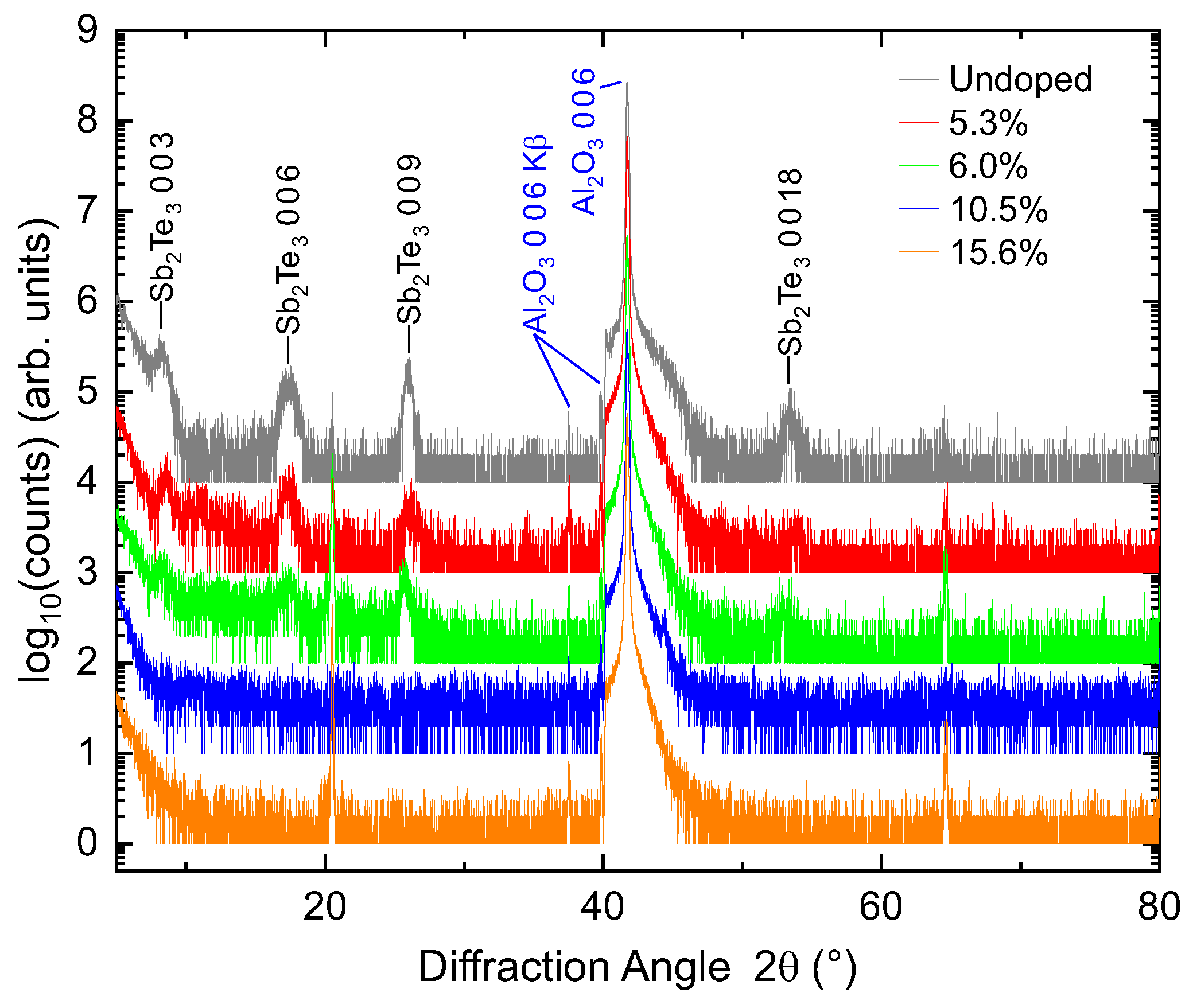
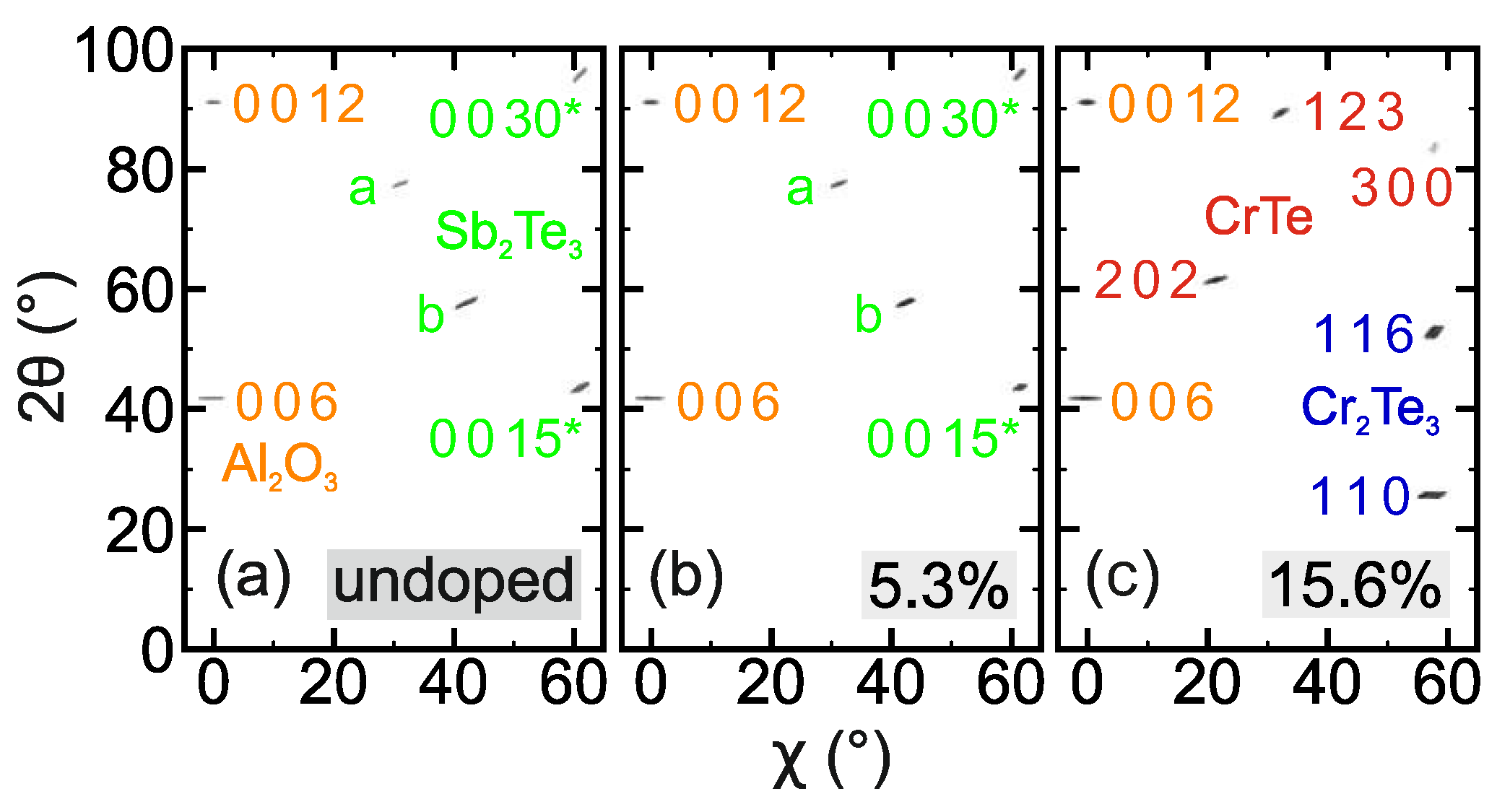
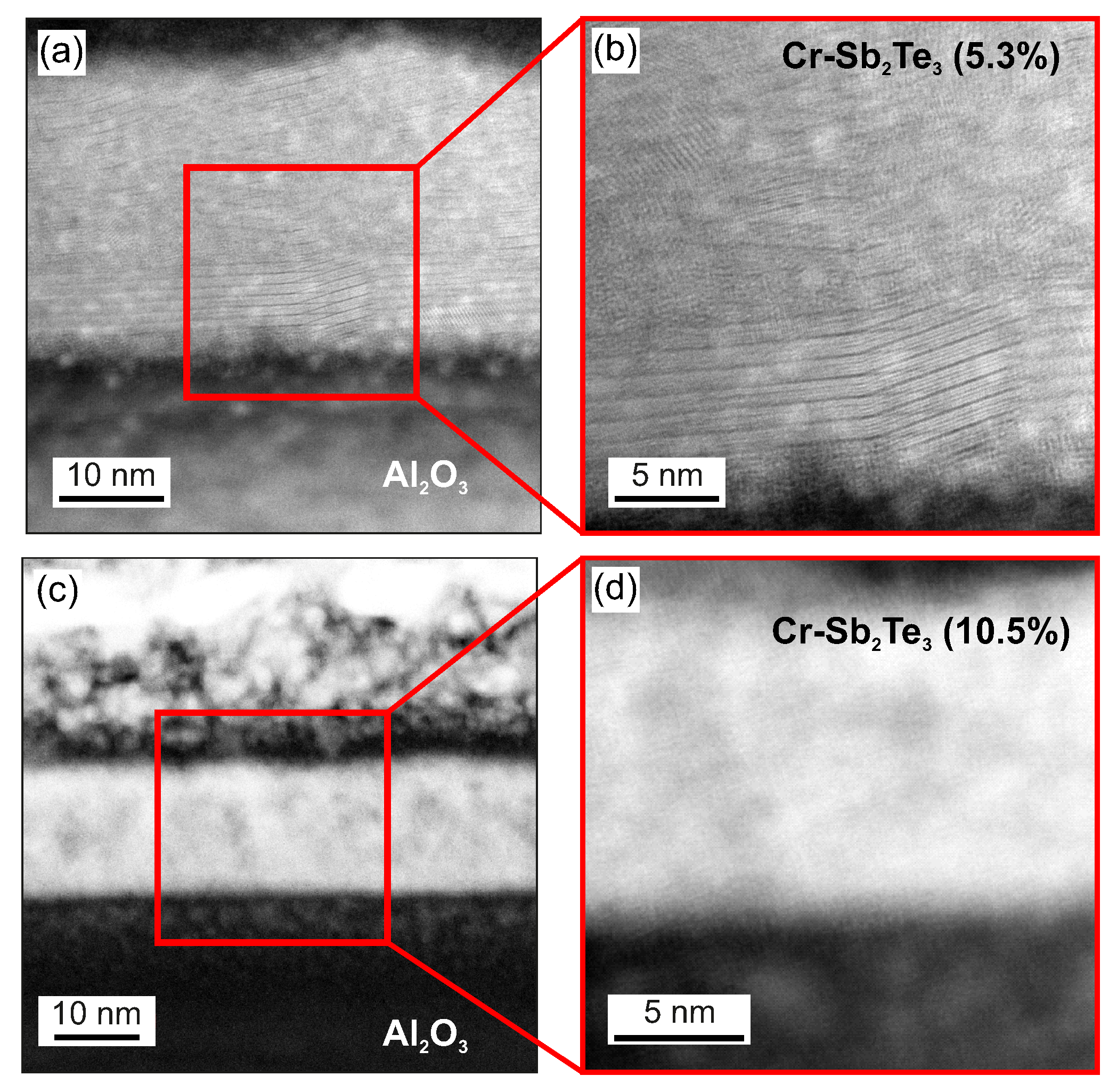
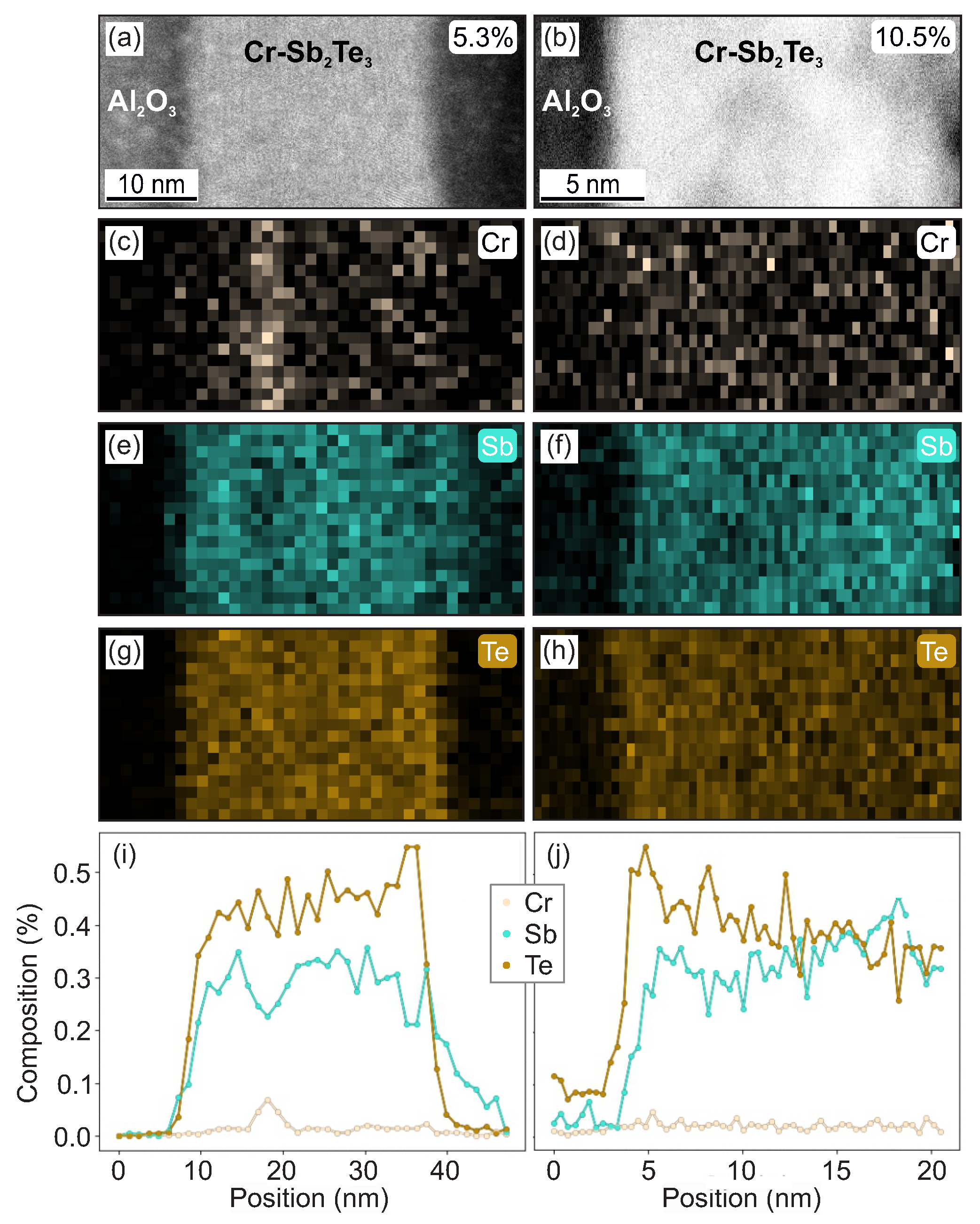
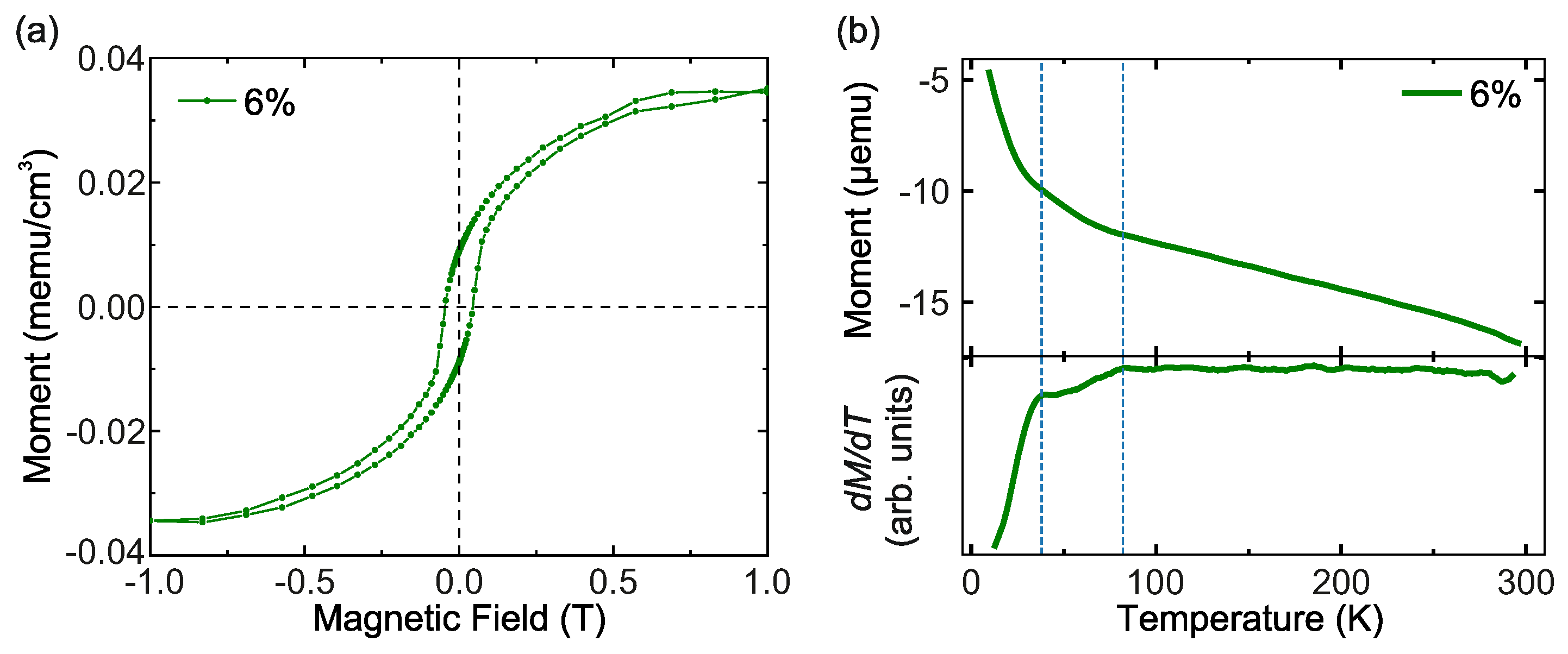
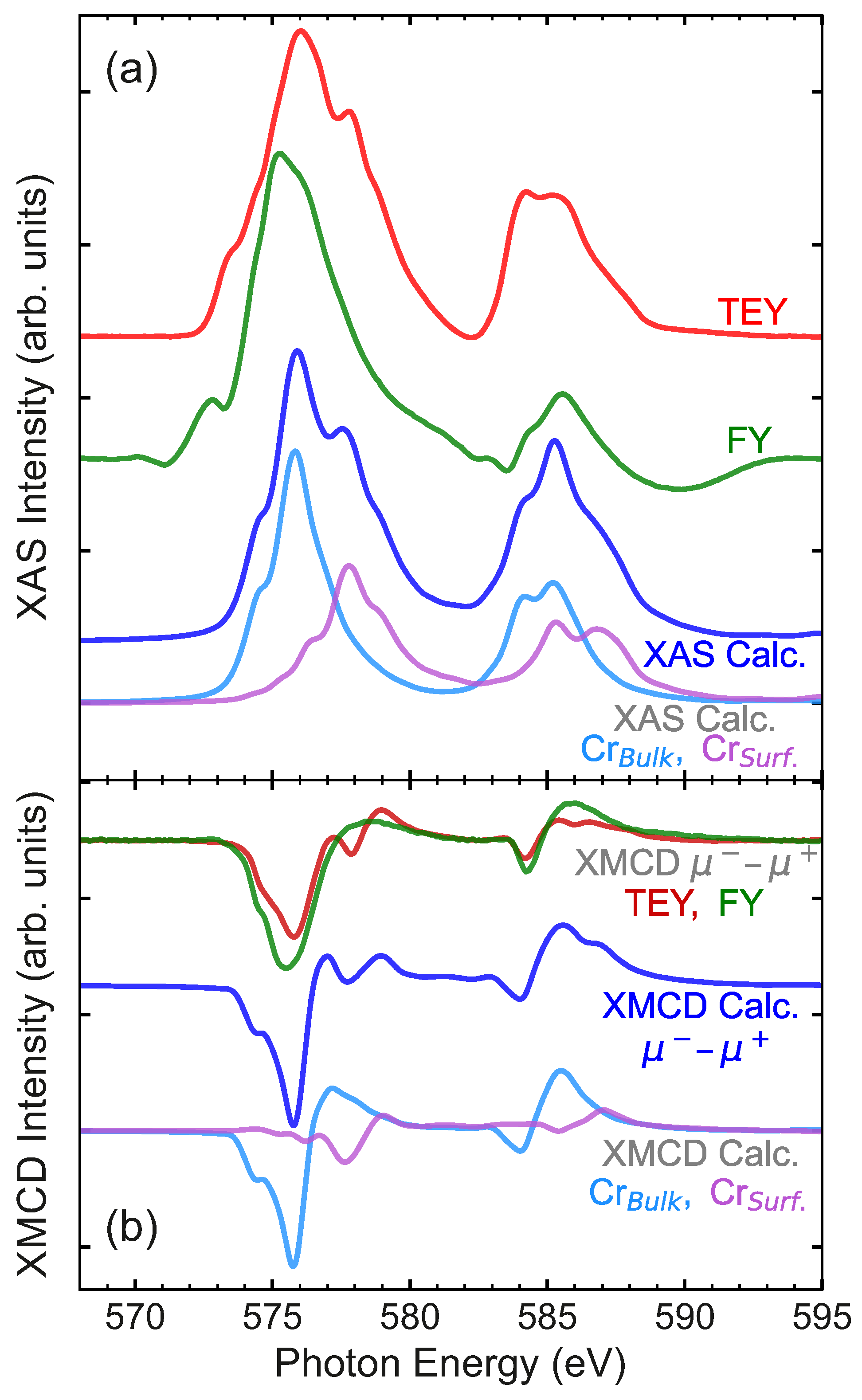
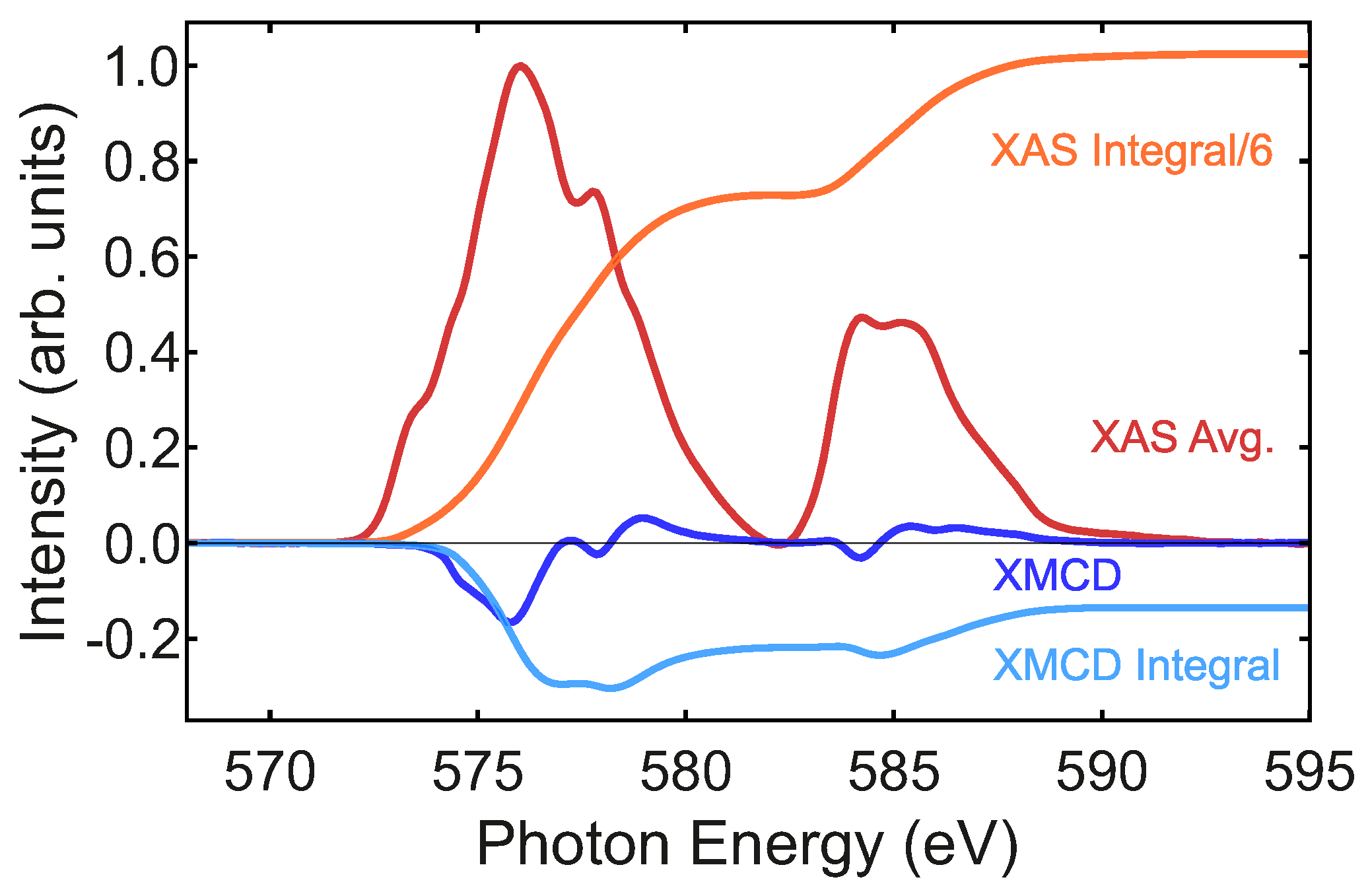
| # | Sputter Power (W) | Concentration (at.-%) | |||
|---|---|---|---|---|---|
| Sb2Te3 | Cr | Sb | Te | Cr | |
| ref | 30 | ||||
| 463 | 30 | 4 | 39.3 | 55.4 | 5.3 |
| 464 | 30 | 6 | 39.2 | 54.8 | 6.0 |
| 467 | 10 | 3 | 37.2 | 52.5 | 10.5 |
| 468 | 10 | 2 | 35.9 | 48.5 | 15.6 |
Disclaimer/Publisher’s Note: The statements, opinions and data contained in all publications are solely those of the individual author(s) and contributor(s) and not of MDPI and/or the editor(s). MDPI and/or the editor(s) disclaim responsibility for any injury to people or property resulting from any ideas, methods, instructions or products referred to in the content. |
© 2025 by the authors. Licensee MDPI, Basel, Switzerland. This article is an open access article distributed under the terms and conditions of the Creative Commons Attribution (CC BY) license (https://creativecommons.org/licenses/by/4.0/).
Share and Cite
Bibby, J.; Singh, A.; Heppell, E.; Bollard, J.; Achinuq, B.; do Nascimento, J.A.; Murrill, C.; Lazarov, V.K.; van der Laan, G.; Hesjedal, T. Structural and Magnetic Properties of Sputtered Chromium-Doped Sb2Te3 Thin Films. Crystals 2025, 15, 896. https://doi.org/10.3390/cryst15100896
Bibby J, Singh A, Heppell E, Bollard J, Achinuq B, do Nascimento JA, Murrill C, Lazarov VK, van der Laan G, Hesjedal T. Structural and Magnetic Properties of Sputtered Chromium-Doped Sb2Te3 Thin Films. Crystals. 2025; 15(10):896. https://doi.org/10.3390/cryst15100896
Chicago/Turabian StyleBibby, Joshua, Angadjit Singh, Emily Heppell, Jack Bollard, Barat Achinuq, Julio Alves do Nascimento, Connor Murrill, Vlado K. Lazarov, Gerrit van der Laan, and Thorsten Hesjedal. 2025. "Structural and Magnetic Properties of Sputtered Chromium-Doped Sb2Te3 Thin Films" Crystals 15, no. 10: 896. https://doi.org/10.3390/cryst15100896
APA StyleBibby, J., Singh, A., Heppell, E., Bollard, J., Achinuq, B., do Nascimento, J. A., Murrill, C., Lazarov, V. K., van der Laan, G., & Hesjedal, T. (2025). Structural and Magnetic Properties of Sputtered Chromium-Doped Sb2Te3 Thin Films. Crystals, 15(10), 896. https://doi.org/10.3390/cryst15100896







